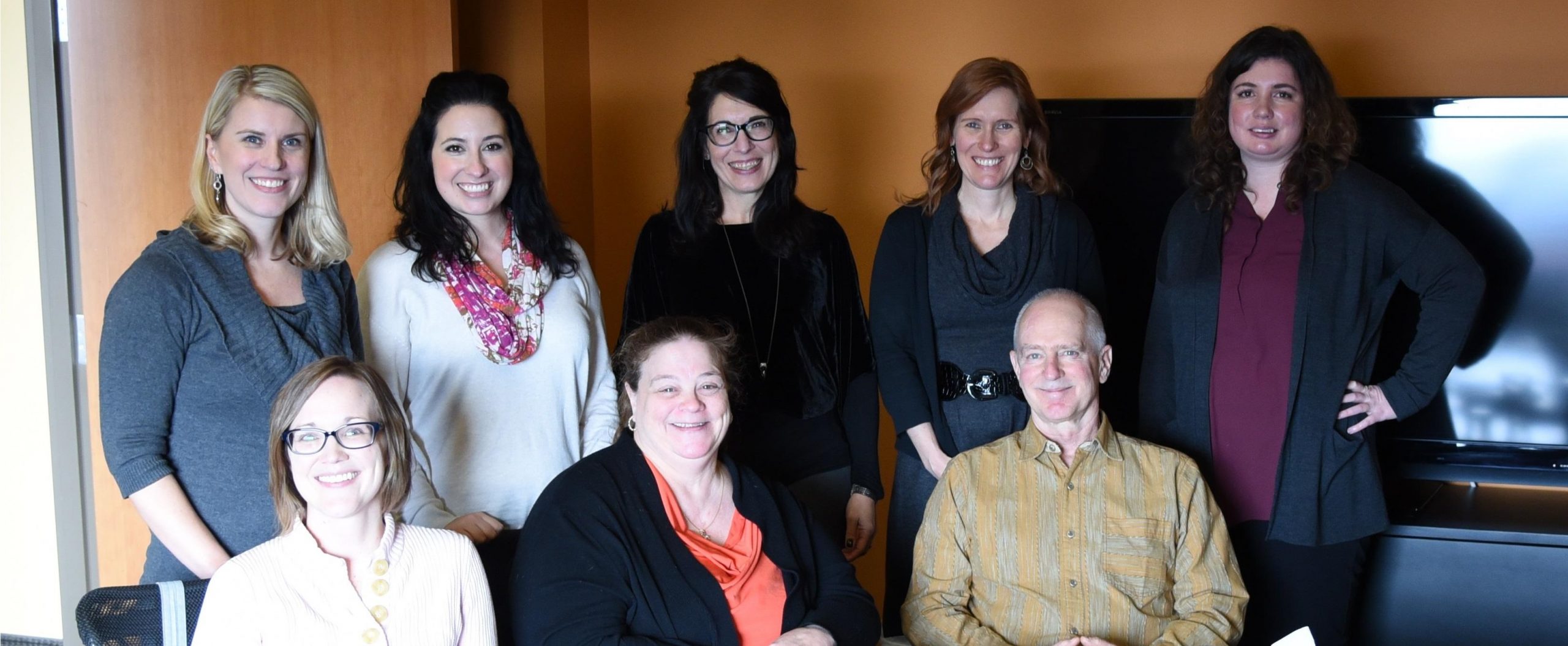
Back row: JoAnn Cintron, Tara Aiken, Molly Hendricks, Jill Stanton, Alison DeRudder Thorpe. Front row: Sarah Walz, Robin Lucas, Dave Lasecke. Not pictured: Amy Keppert.
For several months now, we’ve been hearing from contacts in our community who are asking, “What do you know about Agile in learning and development?” While we at Fredrickson have been working on projects and with clients who are using Agile, we wanted to give them the chance to hear from each other. So, in December, we hosted a small group discussion with several people from the L&D community. The information exchange was lively and interesting, and the insights shared left everyone with a little something new to add to their toolset. We wanted to share some of those same nuggets with you. Here is a short list of our top five insights from this conversation.
- Agile is more than a methodology – it’s a mindset.
This was, perhaps, the key take-away from the meeting. Everyone in the discussion expressed frustration at the change when it was looked at as a replacement for ADDIE. However, a key turning point came for several of our participants when they pushed beyond Agile being just another method for getting work done.
“You have to step-back and internalize it,” shared JoAnn Cintron, Principal L&D Project Manager for C.H. Robinson. This means making the process become part of your daily work habits. The frequent check-ins on progress, being present (even when remote), working small, having constant feedback loops and more touchpoints all contribute to internalizing the methodology.
Everyone agreed that the change doesn’t come overnight, and it is harder for those tied to their habits. However, no one felt it wasn’t worth the effort to make the change.
- Stakeholder involvement is crucial.
Along with working small and having touchpoints, all agreed that securing and constantly involving the stakeholders was a key to long-term success. And many indicated this was easier than transitioning their own teams out of the normal processes.
“There’s already a lot of leadership support and buy-in for Agile,” said Tara Aiken, Sr. Manager L&D Strategy and Logistics, Target, when describing her experience. Others added that there have been successes in both information technology and product development throughout their workplace. Because the business leaders already are familiar with Agile, it makes it easier for those stakeholders to commit when L&D comes to the table saying the same thing.
- ”Fail fast” is not about failure, it’s about achieving success.
“It’s OK to fail fast; getting something in front of a stakeholder fast means you are constantly making the end product better,” said JoAnn. Sarah Walz, Instructional Design Consultant, Optum, agreed. “Agile’s benefits of more frequent touchpoints, faster course correction, and faster consumer and stakeholder buy-in lead to a better end product.”
Everyone involved in our conversation agreed that perfection takes longer (and may not even be possible anyway). The key? Constant feedback and engagement achieved by presenting smaller products faster led to better success.
- Don’t abandon planning for the sake of Agile.
No matter how you adopt the Agile mindset, “you still have to do analysis and design. You have to make sure your educated guesses are close enough,” offered Amy Keppert, Sr. Manager, Learning & Performance, Optum. Without having that early agreement about the business problem being addressed, it’s nearly impossible to get stakeholder involvement on the vision for the solution. And you can’t do that without first laying your foundation.
“Bring stakeholders to your planning and brainstorming sessions,” JoAnn agreed. Involving them in your planning process helps build trust and lets them see you are planning and making progress, and can help you avoid costly rework if you’re getting off track.
- Tools and training help, but team dynamics rule.
In terms of practical tools for managing Agile, those most often mentioned by our group included Jira, Kanbanize® and Trello. Kanban boards were very popular for running meetings. For training on Agile? Agile boot camps, watching what IT was doing, using an Agile coach, and participating in dojos were all ways mentioned.
However, our group agreed that having the right team, with good team dynamics, supplanted any of the tools and training. As Sarah shared, “How can you fail fast? You need to develop a relationship of trust. So, if you disagree with folks but have trust, that’s OK. You can move on. It’s psychological safety. The dynamics of team are so important.”
We’ve heard from others in our community enough to know that Agile is a topic of interest to our broader community, so we are hoping to host one event this year for the broader community. In the meantime, we welcome your comments to our blog. What successes or lessons learned do you have from your experience with Agile? We’d love for you to share as we continue to build insights to this way of thinking!
Contributors: Robin Lucas, VP of Learning at Fredrickson, wrote this post using information from an Agile conversation we had with Sarah Walz, Instructional Design Consultant, Optum; Alison DeRudder Thorpe, Contractor, Fredrickson Learning; Amy Keppert, Sr. Manager, Learning & Performance, Optum; Tara Aiken, Sr. Manager, L&D Strategy and Logistics, Target; Dave Lasecke, Owner & CFO, Fredrickson Learning; JoAnn Cintron, Principal L&D Project Manager, C.H. Robinson; Jill Stanton, Project Manager, Fredrickson Learning; Molly Hendricks, Account Manager, Fredrickson Learning.

Monica Swanson
I’m curious if the discussion also included the reality between Agile (big A) and agile (small a). I’m assuming most L&D teams are “agile” and not “Agile”, which is my experience. Agile is formal methodology and involves scrum, etc. “agile” is not formal and is about delivering results faster through collaboration and iterative development.